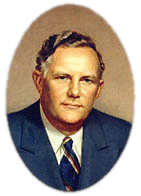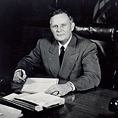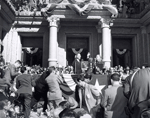|
|
Beauford Halbert Jester (1893-1949), governor, was born in Corsicana, Texas, on January 12, 1893, to Frances (Gordon) and George Taylor Jester. His father was lieutenant governor of Texas for two terms (1894-98) under Governor Charles A. Culberson. Jester attended public schools in Corsicana, received an A.B. degree from the University of Texas in 1916, and entered Harvard Law School, where his studies were interrupted by World War I. Commissioned as captain, he commanded Company D, 357th Infantry, Ninetieth Division, in action at St. Mihiel, Meuse-Argonne, and served with the American Army of Occupation in Germany. In 1919 he entered law school at the University of Texas, where he earned an LL.B. degree in 1920. Afterward he moved back to Corsicana to practice law. Much of his work as an attorney involved representing the oil business and included arguing court cases up to the United States Supreme Court. Jester also managed the land, cattle, and cotton holdings of the family ranch and was president of the Navarro County Bar Association from 1925 to 1938 and director of the state bar in 1940-41. From 1942 to 1947 he was appointed, then elected, to the state Railroad Commission. Jester was a member of the University of Texas Board of Regents from 1929 to 1935 and from 1933 to 1935 was the youngest person ever to chair the board. During his tenure he promoted a UT building program that resulted in the acquisition of construction funds for a general building plan developed in 1933. The tower of the Main Building, Hogg Auditorium, the Texas Union, and Gregory Gymnasium, as well as the expansion of the University of Texas Medical Branch in Galveston, were products of the plan Jester supported. In 1968 Jester Center, an $18 million classroom and residence complex, was named for him.
In 1946 Jester ran for governor as a middle-of-the-road Democratic candidate in a field of fourteen. Governor Coke R. Stevenson is reported to have secretly favored him and to have delayed announcement of his plans not to run, in an effort to bluff other candidates out of the race. Jester defeated the more liberal Homer Price Rainey, his major opponent, in the Democratic primary before defeating the Republican candidate in the election. He proved to be a popular states'-rights Democrat and easily won a second term in 1948. As governor, he presided over the longest legislative session in the state's history to that time, the Fifty-first Legislature, which met from January 11 to June 6, 1949. This legislature passed the first state appropriations bill of over $1 billion, providing funds for prison improvements, for educational reform under the Gilmer-Aikin Laws, for rural-road and state-park expansion, for a youth development council, and for a separate Board for Texas State Hospitals and Special Schools. Although Jester opposed President Harry Truman's national civil-rights program, he supported state civil-rights legislation, including an antilynching law and a proposed constitutional amendment to repeal the poll tax. He lobbied for higher teachers' salaries and statewide college and university building programs, including the establishment of a major university for African-Americans. In 1947 he supported the passage of a right-to-work law that abolished the union shop. His other labor legislation included an anti-checkoff law forbidding the automatic deduction of union dues from paychecks and a law against mass picketing. Jester also advocated state arbitration in contract disputes. His policies earned him an antilabor reputation among union leaders and liberal Democrats.
He married Mabel Buchanan of Texarkana on June 15, 1921. They had three children. Jester was a Methodist and member of a number of fraternal, business, and community organizations. He died of a heart attack on July 11, 1949. He was the first Texas governor to die in office. BIBLIOGRAPHY: Seymour V. Connor, ed., Saga of Texas series (6 vols., Austin: Steck-Vaughn, 1965). Current Biography Yearbook, 1948. George N. Green, The Establishment in Texas Politics (Westport, Connecticut: Greenwood, 1979). Alva Taylor, History and Photographs of Corsicana and Navarro County (Corsicana, Texas, 1959; rev. ed., Navarro County History and Photographs, Corsicana, 1962). Vertical Files, Barker Texas History Center, University of Texas at Austin. Tommy W. Stringer Reprinted with permission from the Handbook of Texas Online, a joint project of the Texas State Historical Association and the General Libraries at the University of Texas at Austin. © 2003, The Texas State Historical Association.
|





